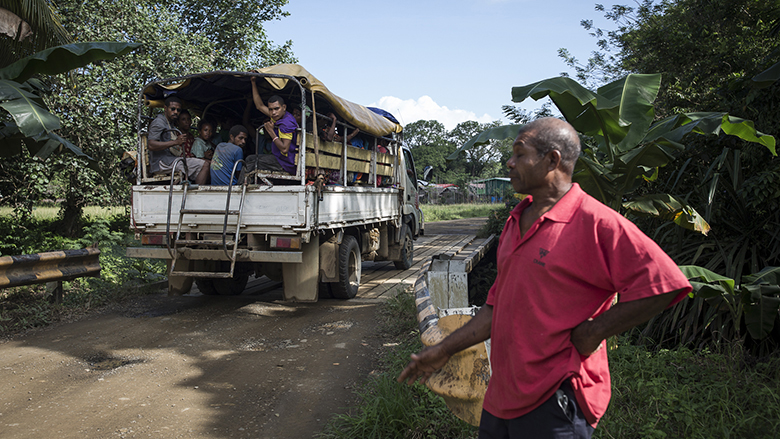In small island states, resilient transport is a lifeline against disasters

In an effort to improve the overall climate resilience of SIDS, the World Bank has significantly increased its support to the transport sector in many of these countries, with a clear focus on adaptation to climate change. In fact, a record number of eight transport projects have been launched in SIDS in the past year, all designed with climate risks in mind.
“Climate change is putting a strain on our client countries and their transport systems. It is a reality that we simply cannot ignore. That’s why, if you look at our transport portfolio in the Pacific, there isn’t a single project that doesn’t include a resilience component,” said Almud Weitz, World Bank practice director for transport in Southeast Asia and the Pacific.
Supporting Pacific SIDS
Although in many cases resilience provisions are part of larger transport projects, an increasing number of projects are fully dedicated to climate risk, reflecting the strategic importance of the transport program for the resilience. A good example is the Pacific Climate-Resilient Transport Program, a series of projects currently covering a total of four countries: Samoa, Tonga, Tuvalu and Vanuatu. Other countries are expected to join the program in a second phase.
“Despite many common vulnerabilities, Pacific SIDS have different infrastructure resilience profiles and priorities. The Pacific Climate Resilient Transport Program is based on a common approach, but can be adapted to meet the specific needs of each country,” noted Sean Michaels, Senior Infrastructure Specialist, who has led the program since its inception. “Across all program countries, interventions include a combination of ‘hard’ infrastructure investments and ‘soft’ capacity building activities to help our clients effectively manage more resilient infrastructure. “
Infrastructure works may involve building additional roads so that key corridors can remain functional even if the main road is damaged, improving drainage, putting up retaining walls, installing netting to contain rockfall and a myriad of other measures dictated by local circumstances.
Technical assistance efforts are equally essential: by strengthening institutions, integrating resilience into infrastructure design standards and policies, and developing sector and spatial planning tools, the program provides significant capacity building that will help countries to manage transport much more effectively in the face of growing climate threats.
By their nature, disasters are unpredictable, and while preparedness is crucial, so is the ability to respond quickly to emergency needs and reconstruction. The program allows countries to reallocate project funds to support recovery operations. Known as the “contingent emergency response component,” this mechanism gives governments much-needed financial flexibility in the aftermath of a disaster.
Relying on a common framework across multiple countries has made projects faster and less expensive, and allows countries to leverage their limited resources as efficiently as possible. SIDS around the world are increasingly looking to work together – after all, when you’re small, your best bet is to find strength in numbers – and the model is well suited to be replicated across countries and sectors.
The momentum for ambitious and coordinated action is clearly building. On the ground, SIDS are equally determined to overcome the obstacles. As climate leaders in the Pacific have said, “small island states are not drowning, they are fighting”.
The activities described above are part of a broader World Bank effort to support climate resilience in small island developing states:


.jpg)

